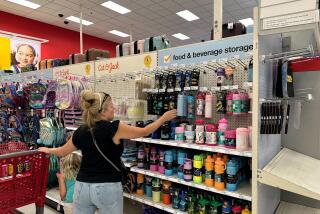Brown bag school lunches have little nutrition - lots of dessert
- Share via
What could be more wholesome for students than a bag lunch packed at home? A lunch from the school cafeteria.
Researchers found that the typical lunch brought from home contained far fewer vegetables, fruit and whole grains than federal nutrition standards advised.
----------
FOR THE RECORD
An earlier version of this post listed quantities of some food items as daily amounts instead of weekly amounts. Lunches served by schools that participate in the National School Lunch Program include 2.5 cups of fruit, 3.75 cups of vegetables, 4 ounces of whole grains and 8 to 10 ounces of meat or meat alternatives over the course of a week.
----------
They also included too much salt, soda and dessert, according to a report published Monday in the journal JAMA Pediatrics by researchers who observed 337 kids at a dozen elementary and middle schools in Houston.
Since 2012, schools that participate in the National School Lunch Program have had to serve meals that meet the standards set down in the Dietary Guidelines for Americans. But there’s no such requirement for those who fill the lunch boxes and brown bags that children take to school.
And in the Houston schools studied, you could certainly tell.
The gaps between the food served at school and the food brought from home were not small:
-- School lunches included 0.5 cups of fruit, but elementary school students’ home lunches included only 0.33 cups of fruit, of which 0.24 cups were eaten, on average. Middle-school students packed 0.29 cups of fruit and ate 0.22 cups.
-- School lunches served up .75 cups of vegetables, while younger students with home lunches packed a measly 0.07 cups of vegetables and ate 0.05 cups of them, on average. The middle schoolers brought a paltry 0.11 cups of vegetables and ate 0.08 cups.
-- Though students should eat at least 0.5 ounces of whole grains during the midday meal, home lunches for elementary school kids contained only 0.22 ounces of whole grains and those for middle-school students had 0.31 ounces, on average.
With so little fruit, vegetables and grains in the home lunches, what foods did the kids bring from home? The amount of meat (or meat alternatives) was in line with federal guidelines of 1 to 2 ounces per day. And home lunches went a little overboard on total grains, averaging nearly 3 ounces per day instead of the recommended 1 to 2 ounces.
The elementary school lunches packed at home also included 4.43 ounces of sugary drinks, 0.58 servings of snack chips and 0.67 servings of dessert -- none of which may be served in cafeterias that follow the National School Lunch Program guidelines. Lunches brought by middle schoolers had a little more chips but a little less dessert and sugary drinks, on average.
Dessert was the most popular item in the middle-school lunch bags -- 101.8% of packed desserts were eaten, the researchers found. The figure exceeded 100% because some kids got extras from their friends or purchased dessert at the school snack bar. Chips were a close second, with 98.7% of those packed being eaten.
For elementary school students, milk (purchased at school) was the item most likely to be consumed (99.1% of it was). Dessert and chips came in second and third, with 92.6% and 90.7% eaten, respectively.
The sodium in home lunches was well in excess of the federal guidelines. Though lunches sold in elementary schools can’t exceed 640 milligrams of sodium, the meals packed by elementary school students contained 1,110 mg, of which 910 were eaten, on average. Lunches sold in middle schools can have up to 710 mg of sodium, but lunches brought from home by middle schoolers had 1,003 mg of sodium, all but 3 of which were eaten.
Home lunches scored well across the board for saturated fat. Federal standards recommend that fewer than 10% of total calories come from saturated fat. Lunches packed for elementary school students delivered 9.92% of their calories in the form of saturated fat; for middle-school home lunches, that figure was 9.03%.
Total calories weren’t too bad either. Elementary school lunches should contain between 550 and 650 calories, the Dietary Guidelines for Americans advise. The home lunches observed in the study averaged 661 calories, but because only 85% of the food was eaten, only 559 calories actually were consumed. Middle-school lunches averaged 616 calories, well within the 600- to 700-calorie target laid out in the dietary guidelines.
The home lunches packed for elementary school students were more expensive than the lunches they could have bought at school, the researchers reported. The total cost of the ingredients in these lunches ranged from 69 cents to $4.78 per meal, with an average of $1.93. A school lunch would have cost $1.80.
The cost of middle-school lunches packed at home averaged $1.76, less than the $2.05 that they would have had to pay to buy lunch at school.
The researchers said they were surprised to find that, overall, home lunches brought to low-income schools cost more than home lunches brought to middle-income schools. “This is a new finding that warrants more investigation,” they wrote.
Now that schools have improved the quality of lunches they serve, it’s time for policymakers to turn their attention to parents and others who pack lunches at home, the researchers concluded.
“It is apparent that a large component of the school food environment -- foods brought from home -- has not been thoroughly investigated and could be a contributing factor to child overweight status,” they wrote.
Hungry for more? Follow me on Twitter @LATkarenkaplan and “like” Los Angeles Times Science & Health on Facebook







